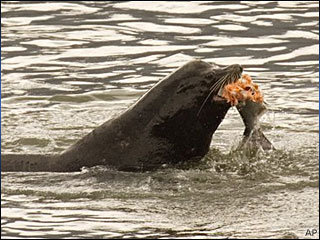forum
library
tutorial
contact

Endangered Fish, Sea Lions Create Quandary
by Mateusz PerkowskiCapital Press, November 12, 2010
|
the film forum library tutorial contact |

|
Endangered Fish, Sea Lions Create Quandaryby Mateusz PerkowskiCapital Press, November 12, 2010 |
Appeals court bounces case back to judge for further deliberations
 Protecting threatened and endangered fish is seldom an easy matter.
Protecting threatened and endangered fish is seldom an easy matter.
Neither dam removal nor fish ladder construction is a cheap or uncomplicated way to restore upriver migration.
Voluminous restrictions on irrigation, cattle grazing and logging aim to prevent harm to fish habitat, but they haven't ended scientific and legal squabbles over the effectiveness of these rules.
The problem of sea lions eating thousands of salmon and steelhead below Bonneville Dam on the Columbia River, on the other hand, appeared to have a straightforward solution: Kill the most gluttonous predators.
As it turns out, that simplicity was deceptive.
The 9th U.S. Circuit Court of Appeals has vacated the federal government's authorization for killing sea lions at the site. The case illustrates the difficulty of making natural resource decisions when federal regulators encounter multiple competing objectives.
In 2008, the National Marine Fisheries Service gave state officials from Oregon and Washington permission to kill up to 85 sea lions a year, as long as the individual animals were identified as particularly voracious.
Non-lethal methods had failed to sufficiently deter the sea lions, which in the past decade have consumed up to 13 percent of the annual spring salmon run and 22 percent of the spring steelhead run, according to NMFS.
Observed predation has ranged from less than 1 percent to more than 4 percent of the combined salmon and steelhead run, but the agency estimated that sea lions probably eat even more fish unseen.
The population of California sea lions -- the main culprits at Bonneville Dam -- had dwindled to about 1,000 individuals earlier in the 20th Century, but has since recovered to about 240,000, according to the agency.
The animals are federally protected under the Marine Mammal Protection Act, but an exemption to that law allows individuals to be killed if they have a "significant negative impact" on threatened and endangered fish.
Considering the mammals' overall robust population and the damage wreaked by roughly a hundred sea lions a year, NMFS reasoned that the proposal qualified for that exemption.
The Humane Society of the United States, an animal rights group, disagreed with that conclusion and challenged it in court, claiming that NMFS violated various federal laws.
U.S. District Judge Michael Mosman sided with the federal government in 2008, but a three-judge panel from the 9th Circuit has now unanimously reversed that decision.
According to the appellate court's opinion, NMFS failed to adequately explain why the agency considers sea lion predation to be a significant threat to fish populations.
Fishing and dam operations inflict comparable harm to salmon and steelhead populations, but the agency has previously deemed these activities to have a minimally adverse effect on their continued survival, according to the 9th Circuit.
Although the ruling is a victory for the Humane Society of the U.S., it may turn out to be temporary.
The 9th Circuit has basically handed the issue back to NMFS for further consideration. The agency may re-authorize the killing of sea lions in the future, if it adequately rationalizes the decision.
All that's required is a "cogent explanation," which does not "impose an undue burden on NMFS," according to the 9th Circuit.
In fact, the court said NMFS has already offered several reasons that "might be valid," such as that sea lion predation at Bonneville Dam "involves mortality from a single source at a single location," whereas harm from dam operations and fishing is more dispersed.
The 9th Circuit also rejected the Humane Society's contention that NMFS should have subjected the decision to a comprehensive environmental analysis. The potential environmental impacts cited by the group did not justify such a review, the opinion said.
Judging from these findings, NMFS may be able to re-authorize the killing of sea lions, so long as it lays out the complexities of a seemingly cut-and-dry decision.
learn more on topics covered in the film
see the video
read the script
learn the songs
discussion forum
